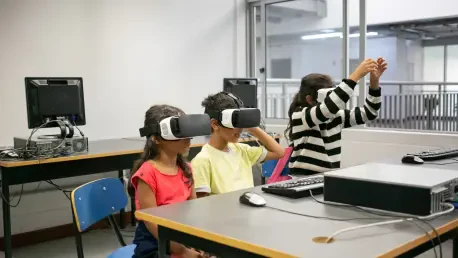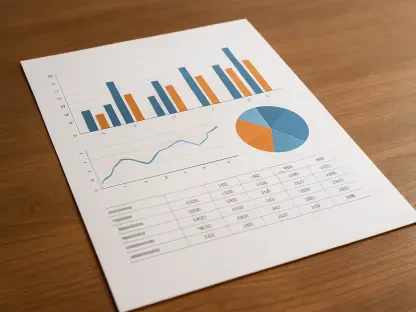Imagine stepping into a virtual reality classroom where the sights and sounds are so vivid that they rival a real-world setting, yet the challenge lies in focusing on a single auditory cue amidst a barrage of visual distractions. This scenario is at the heart of groundbreaking research exploring how visual stimuli can shape auditory attention in immersive environments. Virtual reality (VR) technology has opened new frontiers in understanding human perception, allowing researchers to simulate complex, multisensory experiences that mirror everyday life. By delving into the interplay between what is seen and heard, this study sheds light on the brain’s ability to prioritize information when faced with competing sensory inputs. The findings carry significant implications for educational settings, cognitive science, and the design of VR applications, where maintaining focus is often a critical concern. This exploration not only highlights the potential of VR as a research tool but also raises important questions about how sensory integration functions in dynamic, technology-driven spaces.
Unpacking Cross-Modal Perception in Virtual Settings
Simulating Real-World Challenges with VR
The use of VR to study sensory interactions marks a significant departure from traditional laboratory experiments, offering a more realistic context for understanding attention mechanisms. In a meticulously designed virtual classroom, researchers have crafted an environment that replicates the distractions and stimuli of a typical learning space, complete with visual and auditory elements competing for attention. Participants in the study were tasked with identifying specific auditory cues, such as animal names, from designated spatial positions while navigating a landscape of visual information. This setup aimed to bridge the gap between controlled settings and the unpredictability of real life, enhancing engagement through immersive design and interactive features. The virtual environment not only heightened the sense of presence but also allowed for precise manipulation of variables, providing a unique lens through which to observe how the brain handles multisensory inputs in a setting that feels authentic and relevant to daily experiences.
Enhancing Engagement Through Immersion
Immersion plays a pivotal role in how participants interact with tasks in a VR classroom, amplifying the impact of cross-modal effects compared to sterile lab conditions. The realistic visual context, paired with gamification elements, creates a sense of involvement that can influence attention allocation in profound ways. During the experiments, the presence of visual stimuli—whether aligned or conflicting with auditory targets—demonstrated a clear effect on performance, suggesting that the brain’s processing of sensory information is deeply tied to the environment’s realism. This heightened engagement could explain why visual distractions in VR settings often carry more weight than in traditional setups, as the mind becomes more attuned to the surrounding context. Such findings underscore the potential of VR to not only simulate real-world scenarios but also to reveal nuanced insights into how sensory boundaries are navigated when immersion blurs the line between virtual and actual experiences.
Key Experimental Insights and Their Implications
Effects of Visual Congruence on Auditory Focus
One of the core discoveries from the research centers on how the alignment between visual and auditory stimuli influences selective attention in a virtual classroom. When participants were presented with visual cues that matched the auditory target, such as a corresponding animal image, their response times were generally faster, and error rates decreased compared to auditory-only conditions. However, when the visual stimuli were incongruent—mismatching the auditory input—response times slowed significantly, and errors spiked, indicating a processing conflict. This suggests that the brain struggles to reconcile conflicting sensory information, diverting resources away from the primary auditory task. These outcomes highlight the dual nature of visual stimuli as either a supportive tool or a disruptive force, depending on their relevance to the auditory focus. The implications extend to educational VR applications, where aligning sensory inputs could enhance learning efficiency.
Timing Dynamics in Cross-Modal Interactions
Delving deeper into the temporal aspects, the research explored how the timing of visual stimuli relative to auditory cues affects attention outcomes in VR environments. When visual cues preceded auditory inputs by a short interval, such as 500 milliseconds, congruent visuals often primed the brain, reducing error rates even in challenging auditory conditions. Conversely, a slightly longer delay of 750 milliseconds introduced unexpected effects, with incongruent visuals sometimes lowering error rates by triggering a suppression of previously attended information, allowing focus to shift. This complex interplay reveals that timing is a critical factor in cross-modal perception, distinguishing preparatory priming from simultaneous sensory integration. Such findings emphasize the need for careful design in VR systems, where the sequencing of stimuli can either bolster or hinder attention. This temporal dimension adds a layer of intricacy to understanding how the brain prioritizes sensory data under varying conditions.
Broader Implications for Multisensory Research
Reflecting on the experiments, it became evident that VR offers a powerful platform for dissecting the intricacies of multisensory perception beyond what traditional methods could achieve. The ability to manipulate congruence and timing within an immersive classroom setting provided a clearer picture of how visual stimuli modulate auditory attention, with results varying based on contextual factors. These insights suggest that the brain employs distinct mechanisms for handling preparatory cues versus simultaneous inputs, a distinction that could inform future studies in cognitive neuroscience. Moreover, the enhanced engagement observed in VR points to its potential as a tool for creating ecologically valid research environments that mirror real-world complexities. As technology continues to evolve, leveraging these findings could guide the development of VR applications in education and training, ensuring that sensory interactions are optimized to support focus and learning outcomes in dynamic, interactive spaces.









